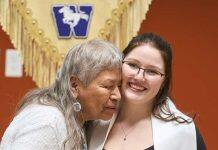When youth with an eating disorder reach the age of 18, they are typically required to move to adult treatment. Connecting with a new system of supports can be tricky and stressful. Researchers at the University of Calgary are establishing and implementing a standardized approach to support youth as they transfer to adult services.


Kloie Picot, for the Faculty of Social Work
“A lot of young people fall between the system cracks,” says University of Calgary Faculty of Social Work researcher Dr. Gina Dimitropoulos, PhD. “Then they end up having difficulties accessing services, which only makes their eating disorder worse while they’re waiting for care.”
Dimitropoulos is the principal investigator behind TransitionED: Co-Designing and Implementing Canadian Practice Guidelines for Transitions for Youth and Young Adults with Eating Disorder, which is being supported over four years, through a Transitions in Care grant from the Canadian Institutes of Health Research (CIHR). The national project brings a wide spectrum of voices into the conversation, including researchers, policy-makers, decision-makers and young people and their families from eating disorder programs across Canada.
Eating disorders on the rise with COVID
Eating disorders exact a terrible toll on youth, their loved ones, and society. COVID-19 has only heightened the need for this research. Last year, Dimitropoulos co-authored a study revealing a 60 per cent rise in hospitalizations for paediatric eating disorders. These disorders can be fatal and have one of the highest mortality rates of all psychiatric illnesses. It’s estimated that in 2017-18, eating disorder treatment cost the health-care system an average of $24,017 per patient.
During the first phase of the study, the research team will bring together key stakeholders and, using a consensus-building methodology, identify potential changes to services and policies that could better support youth in making a successful transition to adulthood and adult-focused services.
Guidelines with a health equity lens
Dimitropoulos says that the guidelines will also be crafted with a health equity lens. Young people from historically marginalized populations can develop eating disorders as a means of coping with the trauma of racism, or to conform to western beauty standards. As a result, they may hesitate to seek treatment.
“We recognize that there are many young people who, for a whole host of reasons including social determinants, racism, implicit biases, don’t even access needed services for eating disorders,” she says.
“So, we’re working with scholars and providers who work with Indigenous youth, racialized youth, 2SLGBTQQIA+ and those experiencing economic disparities who may have unique challenges or barriers and may therefore need support to launch into adulthood and to transition to adult-focused care.”
In the second phase of the study, stakeholders will work together to implement the newly developed guidelines, including service-level interventions in a variety of settings. In the final phase, researchers will test the approaches through a pilot project.
In the third phase of the study, the team will evaluate the implementation of the transition interventions in the Calgary Eating Disorder Program, Alberta Children’s Hospital and McMaster Children’s Hospital Eating Disorder Program.
“We’re going to see what happens as we try to support these young people,” says Dimitropoulos, anticipating the kinds of questions they will need to answer. “Are we able to successfully do this? Were there challenges, barriers, facilitators? How can we address them before we scale up these guidelines across other eating disorder programs in Canada and internationally?”







































